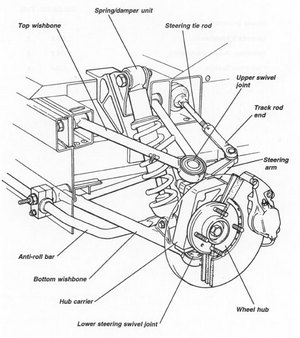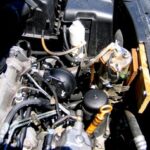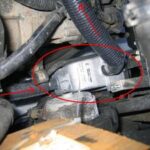We all do the best we can to take care of our vehicles and ensure that we will be safe on the road and that our cars will last us a long time. However, certain problems tend to creep up gradually, and there can often be no warning for certain problems that go wrong with cars. While it may be easy to see certain problems in your car, such as the engine or transmission, other areas can be relatively hard to diagnose. Certainly one of the most difficult areas to figure out a problem in though is the suspension. Car suspensions have a bad rap for being difficult to work on, expensive, and sneaky. Of course, if we just take a little time to learn how to look for suspension problems, and what parts of the suspension can go wrong, we can learn to recognize small problems before they turn into big ones, and thus save both ourselves and our cars a lot of trouble in the long run.
While many may be somewhat unfamiliar with how the suspension works on a vehicle, it is important to realize that it is not just one solid piece. In fact, there are several important components which make up the overall suspension. Keep in mind that different kinds of car also have radically different kinds of suspensions, so there is no quick fix for a suspension problem. However, one of the most common problems, and one of the easiest areas to check are the shocks and struts.
For those who do not know, the shocks and struts on a car are basically the parts which control how the car rides and how it handles bumps on the road. You can think of the shocks and struts as a sort of pillow between your car and the road. The other primary function of the shocks and struts are to keep your vehicle on the road. With bad set of shocks or struts, you can be seriously in danger. Therefore, it is very important to diagnose problems that may occur quickly, before they become a major problem. Luckily, there are a few warning signs to look for that are sure signs something is not quite right with your suspension. Namely, you just want to pay attention to the way that your car drives. If you have noticed that it is becoming shaky or choppy on the highway, or you have a loss of control, than it may be a sign that your shocks and struts are wearing out. Also, if you notice an unnatural tilt to the car when taking corners, it is another warning sign. Bad suspensions can also negatively affect your tires. When your struts are going bad, they tend to bounce up and down a lot more than is normally expected, this sort of constant up and down motion causes irregular wear and tear on your tires. In fact, in many cases, it will actually wear down some areas of the tire while leaving other areas fine. In order to check for this, you simply need to run your hand over your tire, if you can feel ridges or large bumps, than you probably want to have your suspension checked out.
Of course, there is a simple method to test out your shocks and struts without having to pay a mechanic to do it. Either push down on the your hood or trunk, and after a few seconds, let go. Notice the way that the car bounces back up. If it takes more than once bounce to stop moving, you are most likely in need of new struts or shocks. This test can be repeated for whichever area of the car you did not test first, as both the front and rear shocks can go bad.
If your shocks or struts (or both) are bad, than you want to get your car to a mechanic as soon as possible. Note that it makes much more sense to replace the whole system at once instead of piece by piece, and that even though it may be more expensive, it will be much more time and energy efficient to get everything replaced at once, instead of piece by piece. A good general rule of thumb is that once one part of your suspension starts to go, other areas are not far behind, so you can definitely save yourself a little bit of time by taking care of a potential problem before it becomes too bad.
Even though shocks and struts may be one of the most common suspension problems, they are not the only ones, and they are far from the most dangerous. However, one of the most potentially bad areas of the suspension that can go wrong are the ball joints that lie at the end of your strut tower. Keep in mind it is very difficult to tell under normal driving conditions if your ball joints are going bad, so it is important to check them on a regular basis. While you can do this test by yourself, it is very highly recommended, and much easier, to do it with someone else. You need one person to life the car up off the ground slightly so that the wheels can spin freely, as long as they are not in direct contact with the ground you should be fine. Then, take a flashlight and get underneath your car. Right where the suspension meets the wheel you should be able to see a little ball-like joint connecting the two pieces. This is the joint you are looking for. To test it, simply move your wheel up and down, to simulate the effect of hitting a bump on the road. Try and notice whether or not the ball itself starts to separate, even slightly) when you are moving the tire. If there is even slight separation of the ball, than you will want to get that portion of your suspension fixed immediately. A bad ball joint can break under even the lightest of stresses if the conditions becomes too poor, and a broken joint while you are driving can have disastrous results. If the ball joint comes too far apart or breaks completely while driving, your tire actually has the potential to go under the vehicle. Although this is definitely a worst case scenario, it should definitely make clear the value of a five minute check. Any mechanic should be able to fix ball joints for a relatively low price, so there is absolutely no reason why you should not have it checked out.
Very similar to ball joints, another common problem area for most car suspensions are the tie ends. Tie ends are what connect your steering box to your steering arm and then further to your hub assembly. Basically, the rods that pivot your tires when you turn the wheel. So, thinking logically, if you want to test these pieces out, merely life the car up again and move the wheel side to side instead of up and down. Although there are not as obvious signs to look for when checking the tie rods, you will definitely be able to notice a problem. Primarily, the tires will feel loose, and the suspension under the car will start to shake a little. However, if you are unsure about looking under the car to test out the tie rods, you can do a simple test while driving to check them. Simply find any road with a corner, when you come into the corner, step on the gas pedal. If the tie rods are not in good condition, you will feel the car start to shake a little, and “shimmy” a bit. This is a sure sign that you should get your car to a mechanic as soon as possible, it could end up being a major problem for your vehicle.
It is important to remember that any suspension problem can have devastating effects for both you and your vehicle. Driving with a bad suspension, or one that is quickly approaching bad condition can dangerous and have very bad consequences. For that reason, it is very, very worthwhile to take the time to make sure that your suspension is in good shape, or, at the least, that there are not any major problems with it. Although we often tend to forget about the suspensions in our cars, they are a crucial component of how we drive, and a major safety factor. It only takes a few minutes to check the quality of your suspension, and generally suspension problems are not all that costly to fix. However, even if they were, there is absolutely no way to put a price on health and safety. Make sure to keep your suspension in good shape; it could be a matter of life or death.









